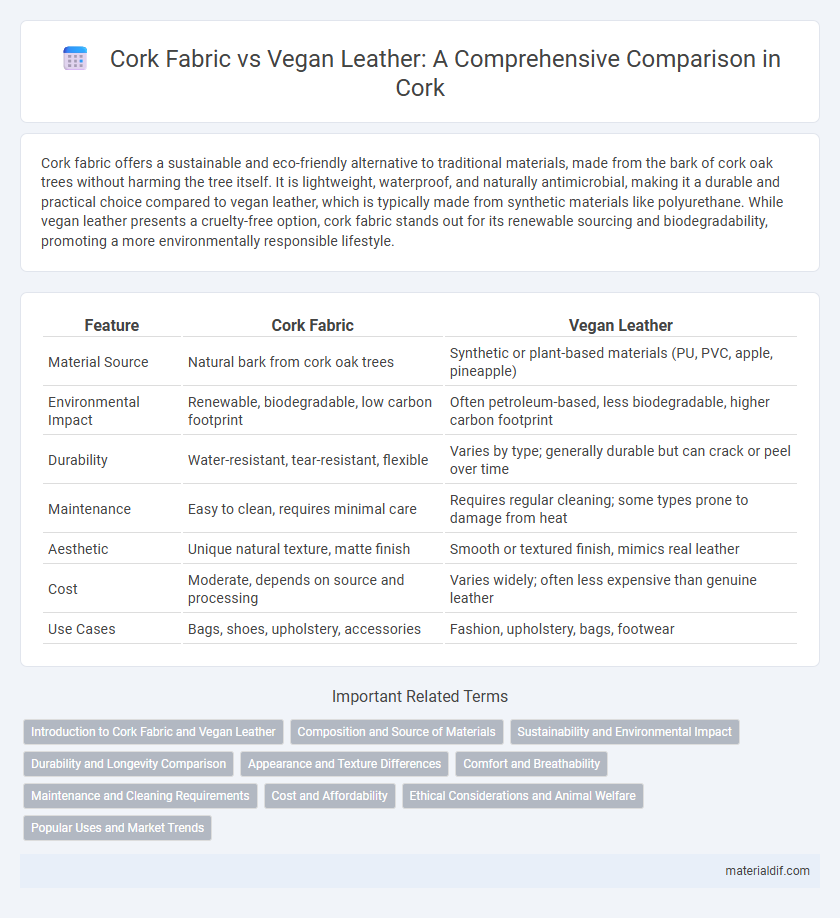Cork fabric offers a sustainable and eco-friendly alternative to traditional materials, made from the bark of cork oak trees without harming the tree itself. It is lightweight, waterproof, and naturally antimicrobial, making it a durable and practical choice compared to vegan leather, which is typically made from synthetic materials like polyurethane. While vegan leather presents a cruelty-free option, cork fabric stands out for its renewable sourcing and biodegradability, promoting a more environmentally responsible lifestyle.
Table of Comparison
| Feature | Cork Fabric | Vegan Leather |
|---|---|---|
| Material Source | Natural bark from cork oak trees | Synthetic or plant-based materials (PU, PVC, apple, pineapple) |
| Environmental Impact | Renewable, biodegradable, low carbon footprint | Often petroleum-based, less biodegradable, higher carbon footprint |
| Durability | Water-resistant, tear-resistant, flexible | Varies by type; generally durable but can crack or peel over time |
| Maintenance | Easy to clean, requires minimal care | Requires regular cleaning; some types prone to damage from heat |
| Aesthetic | Unique natural texture, matte finish | Smooth or textured finish, mimics real leather |
| Cost | Moderate, depends on source and processing | Varies widely; often less expensive than genuine leather |
| Use Cases | Bags, shoes, upholstery, accessories | Fashion, upholstery, bags, footwear |
Introduction to Cork Fabric and Vegan Leather
Cork fabric, derived from the bark of the cork oak tree, is a sustainable, biodegradable material known for its lightweight, water-resistant, and hypoallergenic properties. Vegan leather, often made from polyurethane or plant-based alternatives, mimics traditional leather's appearance while offering cruelty-free and environmentally friendly benefits. Cork fabric stands out for its natural origins and renewability, whereas vegan leather provides versatility and a leather-like texture without animal products.
Composition and Source of Materials
Cork fabric is made from the bark of the cork oak tree, harvested sustainably without harming the tree, resulting in a renewable and biodegradable material. Vegan leather, typically crafted from synthetic materials like polyurethane or PVC, relies on petrochemical sources and is less eco-friendly due to non-biodegradability and energy-intensive production. Cork's natural cellular structure offers breathability and water resistance, while vegan leather's synthetic composition prioritizes uniformity and durability but often at the expense of environmental impact.
Sustainability and Environmental Impact
Cork fabric, derived from the bark of cork oak trees, offers a renewable and biodegradable alternative to vegan leather, which primarily relies on synthetic materials like polyurethane and PVC that contribute to microplastic pollution. Cork production supports biodiversity by allowing cork trees to live for decades, absorbing CO2 and preventing deforestation, whereas vegan leather manufacturing often involves fossil fuel-based resources with higher carbon footprints. Its natural breathability and durability reduce waste compared to the shorter lifespan and environmental strain associated with synthetic vegan leather products.
Durability and Longevity Comparison
Cork fabric offers superior durability compared to many types of vegan leather due to its natural resistance to wear, water, and abrasion. Its unique cellular structure enables it to maintain flexibility and integrity over extended periods, making cork an ideal choice for long-lasting products. Unlike synthetic vegan leather, cork does not crack or peel, ensuring enhanced longevity and sustained aesthetic appeal.
Appearance and Texture Differences
Cork fabric displays a natural, matte finish with a slightly textured surface that highlights its organic patterns, creating a unique and eco-friendly aesthetic. Vegan leather typically has a smoother, glossier appearance, mimicking traditional leather's sleek look but often lacking the distinct grain variations found in cork. The tactile feel of cork fabric is soft yet firm with a slight sponginess, whereas vegan leather feels more uniform and sometimes artificially slick or plasticky.
Comfort and Breathability
Cork fabric offers superior comfort and breathability compared to vegan leather due to its natural cellular structure that allows air circulation and moisture wicking. Vegan leather, often made from synthetic materials like polyurethane, tends to trap heat and sweat, reducing overall comfort during prolonged use. This makes cork fabric an ideal choice for footwear and accessories where ventilation and comfort are essential.
Maintenance and Cleaning Requirements
Cork fabric requires minimal maintenance, needing only a gentle wipe with a damp cloth to remove dirt and occasional conditioning with natural oils to maintain its flexibility. Vegan leather demands more frequent cleaning using mild soap and water, and it may require special conditioners to prevent cracking or peeling over time. Cork's natural water resistance and breathability make it easier to clean and more durable compared to synthetic vegan leather alternatives.
Cost and Affordability
Cork fabric offers a cost-effective alternative to vegan leather, typically priced lower due to its sustainable harvesting process and minimal industrial treatment. Vegan leather often involves synthetic materials that increase production costs, making cork a more affordable option for eco-conscious consumers. The durability and lightweight nature of cork also contribute to long-term savings by reducing the need for frequent replacements.
Ethical Considerations and Animal Welfare
Cork fabric offers a sustainable and cruelty-free alternative to vegan leather, as it is harvested from the bark of cork oak trees without harming the tree or wildlife. Unlike synthetic vegan leathers, which often rely on plastics derived from fossil fuels, cork fabric is biodegradable and supports responsible forestry practices that protect biodiversity. Choosing cork fabric aligns with ethical considerations by reducing animal exploitation and minimizing environmental impact in the fashion industry.
Popular Uses and Market Trends
Cork fabric is increasingly favored in sustainable fashion and accessories due to its eco-friendly, lightweight, and water-resistant properties, making it popular for bags, wallets, and footwear. Vegan leather continues to dominate the market with diverse applications from apparel to upholstery, driven by consumer demand for cruelty-free alternatives and innovations in polyurethane-based and plant-based materials. Market trends indicate a growing preference for cork fabric in niche, eco-conscious segments, while vegan leather maintains broad appeal with advancements in texture, durability, and environmental certifications.
cork fabric vs vegan leather Infographic

 materialdif.com
materialdif.com